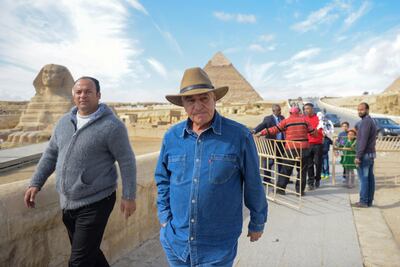One of Egypt’s most celebrated archaeologists is calling for London to return the Cleopatra’s Needle obelisk on the banks of the Thames if the city will not restore the monument.
Zawi Hawass, a former minister of state for antiquities, told The National the 21-metre-high obelisk should be the centrepiece of a binational celebration in 2019 to ensure the public are more aware of its history.
Cleopatra’s Needle is one of two obelisks gifted to the UK and US by the Khedive Muhammad Ali Pasha in 1819. Its American twin is located in New York’s Central Park but the London version stands in an unloved part of the Victoria embankment.
Next year will be the 200th anniversary of the Khedive's gift of Cleopatra’s Needle to Britain. It was given to commemorate Lord Nelson and Sir Ralph Abercrombie’s victories over the French in the battles of the Nile and Alexandria during the Napoleonic Wars.

Although it was officially granted to the UK in 1819, it took a further 59 years to begin to transport the 224-tonne stone from Alexandria to the UK. During the journey, it was almost lost in a storm at sea but was eventually placed in its current position in September 1878.
The obelisk was originally made for Pharaoh Thotmes III 1460 BC and is almost 3500 years old. It was restored in 2005, but since then, Dr Hawass says, it has been forgotten.
"I don't believe, as an archaeologist, that any squares in Egypt or outside of Egypt should have pharaonic statues or obelisks, it's bad," the man dubbed Egypt's Indiana Jones told The National. "The location should be in a temple or museum, not in a square.
“But if it is in a square, it should be treated nicely. I went to see it yesterday and I was ashamed.”
In addition to restoring the obelisk, Dr Hawass would like to see the government create a site management programme to allow the obelisk to be seen by the public and to celebrate the bicentenary.
"If they don't care, they should return it," he told The National.
However, Dr Hawass sees returning the obelisk as a last option, stating his belief that the English people “deserve” to have it.
“The English, they care about the pharaohs, they care about Ancient Egypt, I can see that from my lectures and the emails I receive,” he said.

“I am excavating now in the Valley of the Kings and I see many English tourists and I see the love in their hearts”.
Dr Hawass has not spoken to UK officials about the obelisk, but says he is submitting a report on the issue to the current minister of antiquities in Egypt, asking him to write to the London Mayor’s office with his suggestions.
Yehia Segini, who is part of a group endeavouring to preserve Alexandria’s colonial-era heritage, is another campaigning for a commemoration of the bicentenary of the obelisk's gifting. He is fundraising to build a replica of Cleopatra’s needle to be placed where the original once stood in Alexandria, and a celebration at both monuments to commemorate the gift.
“The common people need a more visible and tangible way by which they can start to think of the West as a friend rather than foe,” Dr Segini wrote in a letter to London's mayor Sadiq Khan requesting his backing for the project in August. “Symbolic acts may be more valuable now than ever before.”
This isn’t the first time Dr Hawass has criticised the way Egyptian artefacts have been displayed in the UK. When the British Museum displayed footballer Mo Salah’s boots alongside pharaonic artefacts, Dr Hawass said: “If the British Museum wanted to honour Salah, it should have built a museum for him or put the shoe in a special room,” calling the decision “completely inappropriate”.
The Westminster City Council Cabinet Member for Environment and City Management said: "Cleopatra's Needle is one of our most distinctive monuments. As such we regularly clean and polish the obelisk's bronze work and have invested in its restoration in recent years.
"The obelisk famously suffered from bomb damage during the blitz - this damage is now part of its history and won't be repaired."
The trees surrounding the monument are under the care of Transport for London.


